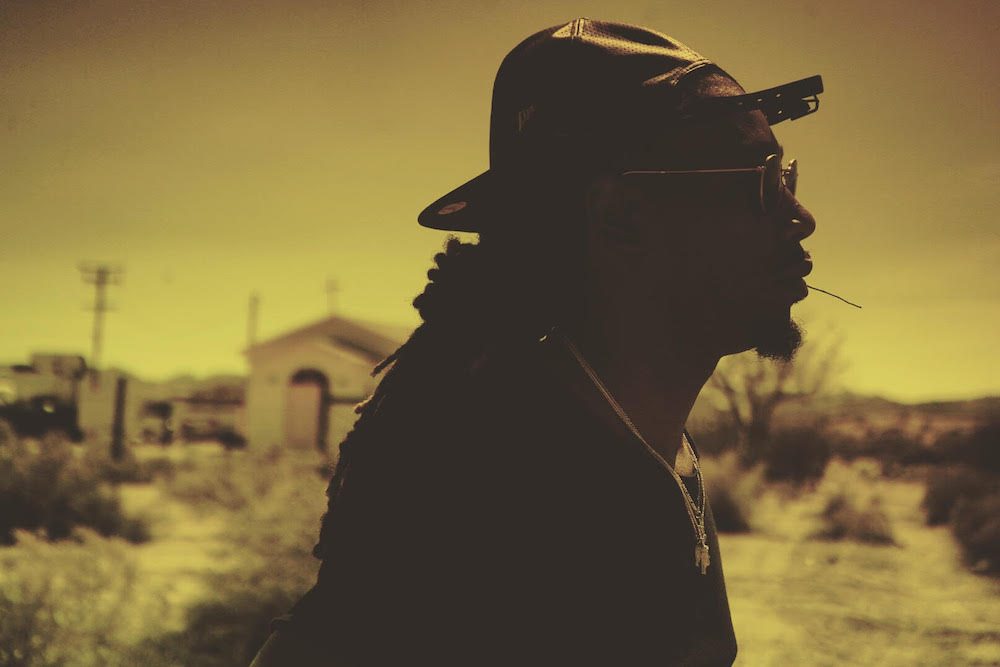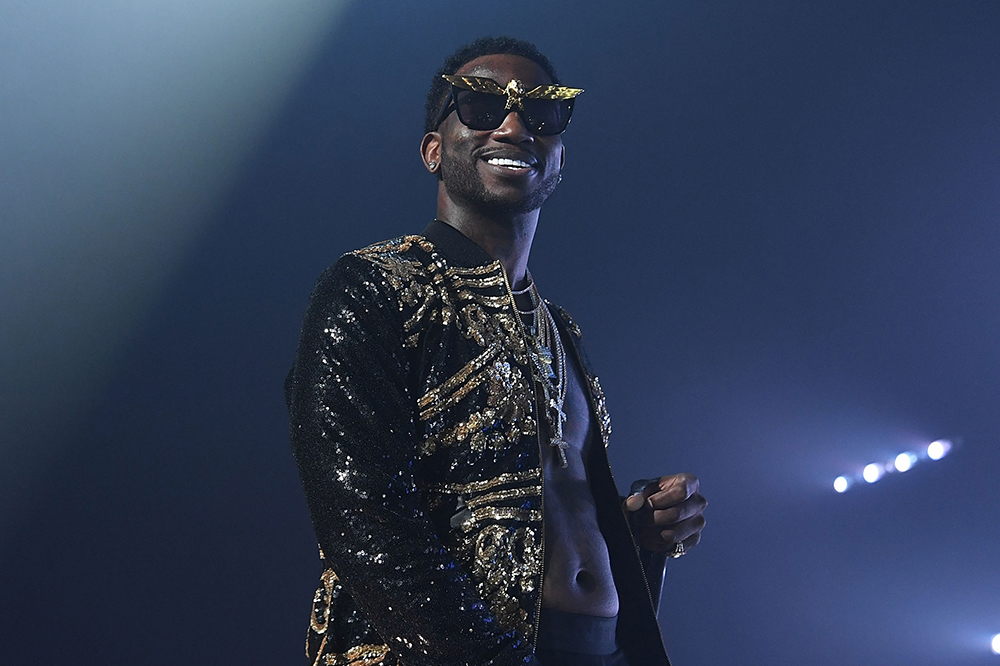Making an album in six days is the work of a Trap God, but the miracle of Everybody Looking‘s existence isn’t enough. True to his marketing genius, Gucci Mane knew he needed the visuals to go along with his myth-making return from jail — house arrest be damned.
That’s where video director Gabriel Hart, a.k.a. Video God, came in. He was hanging out in an empty pool at the video shoot for Wiz Khalifa and Juicy J’s “All Night” when he saw a missed call. It came from Amina Diop, Gucci Mane’s business consultant and executive assistant.
“Whenever Amina calls, it’s concerning Guwop or it’s concerning [rapper Peewee Longway]: I knew it couldn’t be Peewee so I was thinking maybe it’s Gucci,” Hart tells SPIN over the phone. “So I called back and Gucci was on the phone and was like ‘Let’s go in. Time to go.’ So I cleared my schedule.”
So, Hart was tasked with making multiple videos for the rapper — each one mildly different from the next — with a variety of restrictions: The conditions of Gucci Mane’s prison release only made him available for about seven hours a day, and barred shooting in the hood or the strip club. But Hart made do, directing campy subversions of Guwop’s street-star aesthetic. The club and its vices got replaced with pillow fights and bathtubs. Why trap when you can enjoy the wealth? The music videos became representations of one of Gucci Mane’s essential dichotomies: the respect-comes-first intimidator and the self-effacing humorist.
The series of Everybody Looking clips — a dozen in total, with seven having already been released over the past few weeks — has a family reunion feel, with fellow Atlanta superpowers Young Thug, Mike WiLL Made-It, and Zaytoven (who both produced the majority of Everybody Looking) all making cameo appearances. But don’t make the mistake of thinking this wasn’t still a grind for both rapper and director. Hart elaborated on the shooting process for SPIN.
Were you surprised that you got the call?
Not really, because I had talked to Gucci Mane when he was in jail several times. I did a couple things for his mixtapes and stuff. So we had communicated while he was locked up for over a year, and then right before he got locked up, I did all his videos.
The day before he got locked up we shot a video called “Scarface,” and he was on the run. They were looking for him on the news: The story about him being wanted was on while we’re shooting, and everybody just acted like they didn’t see it. We were acting like “What? I ain’t see s**t. Ain’t nothing on the TV.”
How did you meet Gucci?
The first time I met Gucci Mane was in the South DeKalb Mall in about 2001 — this was before I started doing videos. I’d seen him in a clothing store and he had this big-ass Bart Simpson chain on. You know how you see somebody and you start to feel like you know them already? I knew he was Gucci Mane, but I wasn’t in the industry: I just seen a nigga with a stupid-ass Bart Simpson chain.
The first time I met him on some work s**t was when Coach K [Gucci Mane’s former manager] had called me to come meet him at Patchwerk Recording Studios in Atlanta. He and Waka Flocka were in the studio, and he asked me [if I had] a camera. So right that second, we just started shooting “Gucci Two Times.” Five minutes after I meet him, the nigga put some money in my pocket and we started shooting. Ever since then it’s been respect.
Was there more pressure making Gucci Mane’s comeback videos as opposed to something like Jeezy’s “My President”?
Neither situation had any pressure, but I would say the limitations that I had with Gucci Mane were far superior because he only could shoot in the house, and we could only have people at the set that was approved by his probation officer. The federal government had to approve everybody on the crew and that took a couple of days. So if someone had a criminal past or whatever, we couldn’t get them to work.
We had to get permission like a week ahead of time to get him clearance, so he could get security in place and they could vet out the locations. Whatever they did, they had to do it before he came, and that meant we couldn’t do a lot of stuff in the hood. You know his brand is in the trap, East Atlanta, riding people around. The cliché, trap nigga s**t we couldn’t do, so that kind of forced me to think outside of the box and be creative — 80 percent of the videos are done in the house. We shot like eight videos in two days, and then he called me back and we did four more in two days.
[I know] he likes that realism — and that couldn’t happen. So I went to expressionism. I built sets that represented the trap — a campy expressionism. It was like, “OK, let’s have the fire hydrant inside and graffiti everywhere.” Like, German expressionism-influenced.
What impression did you have of the songs before shooting the videos?
I didn’t hear the songs until we got to set. Sean [Paine], the engineer, played the songs off the hard drive. Everything was super-incognito when it came to the music, because you’re dealing with his music and you don’t want it to get leaked or nothing like that. I was in L.A. when he called me, so I flew to Atlanta, created the whole set, and hadn’t even heard the music. I was basically going off the title of the song.
[With “Pick Up the Pieces”], I figured that had to do with something that was aggressive and dark, and then we [would have] him pick up the pieces. To me, that symbolized a fresh new start. I didn’t want to do too much, but I didn’t want it too simple, so I kind of had him stunt or rap in front of this set design that we built from a bunch of frames, and I replaced the pictures with all his old mixtapes. Then in the video he had a bat, and he’s breaking all the picture frames with the mixtapes in them, and the pieces of the glass fall to the ground — but the glass turns into his necklace, into his jewelry. Then he picks the jewelry up and puts it on his neck. The concept of the video was made without hearing the song, so luckily it fit.
For the “First Day Out Tha Feds” video, whose idea it to come up with the clones of Gucci Mane in those scenes?
I had already kind of figured, “How can I be creative with a short amount of time?” That was just my instinct kicking in: “All right, let me do split-screen, and do a multiple-Guwop situation, and that way we can just be creative in one room.” But all of a sudden something funny happened, and people started talking about him being a clone and I was like, “Wow.” We had already shot the video before the rumor had started.
Y’all were ahead of the game.
That’s why he was embracing it. He was calling me like, “Man, that s**t crazy. They thought that I was a clone for real.” He started running with it, which was great, because most people would probably vehemently deny that they were a clone. But he just kind of embraced it, and that’s the mark of a genius. It’s something that’s embedded in him — to understand and not take everything so f**king serious. That’s the part of Guwop people don’t understand. I mean you’re going to respect him, but he don’t walk around like no f**king bully.
You have Zaytoven, Mike WiLL Made-It, and Young Thug in the crib, too — all these artists Gucci Mane influenced. Did it feel a bit like a family gathering?
Well, the first day I walk on set, it’s Drake, me, Mike WiLL, Thug, Zaytoven, Gucci Mane, and Todd Moscowitz. Heavy f**king hitters, just hanging around. I mean, Mike WiLL supported him so hard. Every f**king take, every f**king shot, Mike WiLL is right there beside me, helping me make decisions: Should he wear these shoes? What shirt? Keyshia Ka’oir [Gucci’s girlfriend] was there every day supporting.
You know Gucci has his grand piano in the living room. Everyone’s seen the piano at this point, but I like playing music in between takes, and I love that Zaytoven can play — he’s a classically trained pianist. When me and him shot the [Migos] “Versace” video together, I asked him to play the song while I’m filming him in the “Versace” video. I said “Zay, do you mind playing the real chord?” and he said, “Wow, no one’s ever asked me that.”
So I kind of remembered that and I said “Zay, could you play the real song?” for “Guwop Home,” and it sounded so beautiful. He added his extra element to it, so it inspired me to say, “OK, well I want Thug and [Gucci Mane] to start at the top of the stairs, and I want y’all to walk down like some mafia s**t.” It became Zaytoven playing this classical rendition of “Guwop Home” and Thug and Gucci walking down the steps surrounded by all these girls.
Zaytoven would play Mary J. Blige and Lauryn Hill — I mean, the nigga would give us an encore concert in between takes. And so you got him on piano playing a Lauryn Hill song, and Drake still vibing and s**t, Gucci doing his freestyles. [It was] like a creative cesspool that nobody could top. Everybody was understanding that this is an important moment for Gucci Mane, and it wasn’t about money. It was about making the right re-entrance, and doing the best we could to make his transition from house arrest back into the rap game as admirable and respectable and with as much integrity as possible.
We didn’t want to just throw these motherf**kers together. Gucci was like “Man we gotta have the best videos and get Video God to do it. Let’s get quality over quantity.” But we f**ked around and did quantity and quality.





